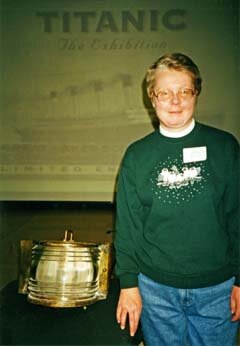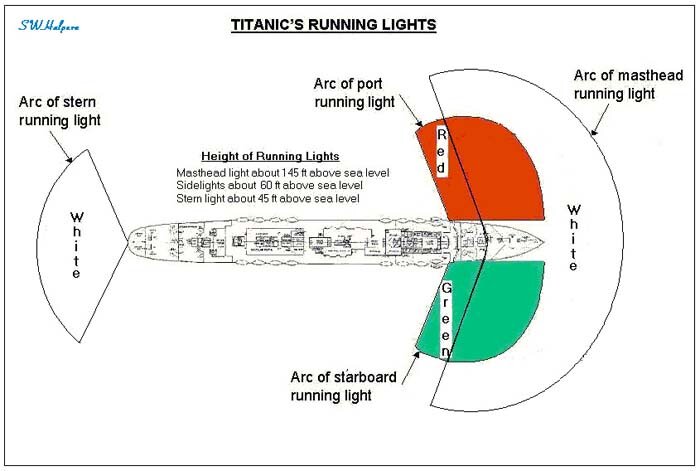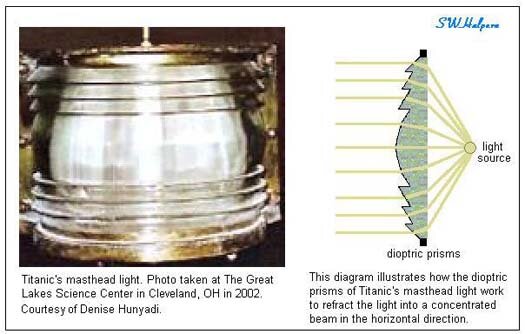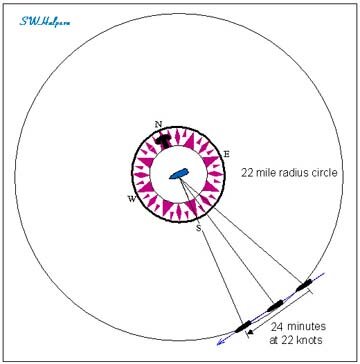|
The 5 mile visibility requirement for the mast light was a minimum visibility distance. It was written to allow for oil lamps to be used. As Boxhall admitted, he believed he could see mast lights more than the regulation distance. But was he correct in believing that mast lights could not be seen at 14 miles?
The Titanic carried a single masthead light on her foremast about 145 feet above the water. To be seen at a distance the light had to be above the horizon of the observer. It also had to be bright enough to be seen and recognized for what it is. For example, consider a person standing on the deck of a typical tramp steamer with a height of eye above the water of 45 feet. If the Titanic’s masthead light were bright enough, that observer should notice the light coming over the horizon when it is 22 miles away, the maximum geographic range between light and observer. But would Titanic’s masthead light be noticed at that distance? Was it bright enough?
 According to author and TRMA trustee Bruce Beveridge, Titanic’s electric masthead light developed a total of 32 candlepower (CP) from 2 filaments of 16 CP each. One candlepower is equivalent to 12.57 lumens. Therefore, the filaments produced a total of 402 lumens of light intensity, about as much as a typical 40W incandescent bulb. Now it happens that a single candle seen at a distance of 1098 meters, or 3602 feet, will appear as bright as a 1st magnitude star. Since brightness falls off as the square of the distance, something that is 32 times as bright as a single candle should appear just as bright when seen at a distance of 5.66 times further away. Therefore, without any lens amplification, a 32 CP light would appear as a 1st magnitude star at a distance of about 20,400 feet on a clear dark night, a distance of 3.4 nautical miles. According to author and TRMA trustee Bruce Beveridge, Titanic’s electric masthead light developed a total of 32 candlepower (CP) from 2 filaments of 16 CP each. One candlepower is equivalent to 12.57 lumens. Therefore, the filaments produced a total of 402 lumens of light intensity, about as much as a typical 40W incandescent bulb. Now it happens that a single candle seen at a distance of 1098 meters, or 3602 feet, will appear as bright as a 1st magnitude star. Since brightness falls off as the square of the distance, something that is 32 times as bright as a single candle should appear just as bright when seen at a distance of 5.66 times further away. Therefore, without any lens amplification, a 32 CP light would appear as a 1st magnitude star at a distance of about 20,400 feet on a clear dark night, a distance of 3.4 nautical miles.
But now we have to take into account the amplification of the masthead light lens; i.e., its light gathering power. The recovered masthead light from the Titanic is seen at right in a photograph from Denise Hunyadi taken in 2002 at the Great Lakes Science Center in Cleveland, OH. From what was described by Denise, Titanic’s masthead light lens is about 8 inches in height.
Using the principal of reciprocity, the gain of a lens in transmitting light is the same as the gain of a lens in receiving light. Normally the increase in light gathering power of one lens relative to another is the ratio of their areas. However, a masthead light lens only had amplification in the vertical plane which concentrates the light into a beam along an arc in the horizontal plane extending 112.5° to both sides of dead ahead. Since the amplification of the lens was only in the vertical plane, the amplification factor we have to use is the ratio of the height of the lens to the diameter of the lens opening of the human eye, which is about 0.32 inches on a very dark night. Therefore, the ratio we are interested in is 8/0.32 = 25. This concentration of light in the optics of Titanic’s masthead light lens is shown in the diagram below.
|
|
|
Since brightness falls off as the square of the distance, something 25 times more bright can be seen 5 times further away. Therefore, if without the lens the light would appear as a 1st magnitude at 3.4 miles, with the lens it would be just as bright at 5 x 3.4 = 17 miles. When this light first comes over the visible horizon 22 miles away from someone on the bridge of a ship such as the Californian with height of eye 45 feet above the water, it would appear as a star of magnitude 1.56, about as bright as the bright star Castor in the constellation Gemini, unmistakable in its movement even if it were moving tangentially near the horizon. In just 12 minutes at 22 knots, Titanic’s masthead light would be seen to change its bearing by 1 full point on the compass. In 24 minutes its bearing would change a full 2 points on the compass. This is shown in the diagram below.
|
|



 According to author and TRMA trustee Bruce Beveridge, Titanic’s electric masthead light developed a total of 32 candlepower (CP) from 2 filaments of 16 CP each. One candlepower is equivalent to 12.57 lumens. Therefore, the filaments produced a total of 402 lumens of light intensity, about as much as a typical 40W incandescent bulb. Now it happens that a single candle seen at a distance of 1098 meters, or 3602 feet, will appear as bright as a 1st magnitude star.
According to author and TRMA trustee Bruce Beveridge, Titanic’s electric masthead light developed a total of 32 candlepower (CP) from 2 filaments of 16 CP each. One candlepower is equivalent to 12.57 lumens. Therefore, the filaments produced a total of 402 lumens of light intensity, about as much as a typical 40W incandescent bulb. Now it happens that a single candle seen at a distance of 1098 meters, or 3602 feet, will appear as bright as a 1st magnitude star.